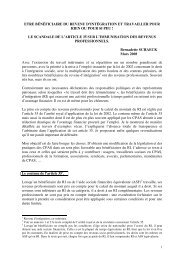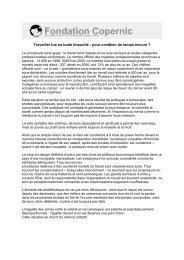Awra Amba RJ 300612 EN - Contacter un comité local d'Attac
Awra Amba RJ 300612 EN - Contacter un comité local d'Attac
Awra Amba RJ 300612 EN - Contacter un comité local d'Attac
You also want an ePaper? Increase the reach of your titles
YUMPU automatically turns print PDFs into web optimized ePapers that Google loves.
1. Method<br />
This work is a synthesis of the available data on the <strong>Awra</strong> <strong>Amba</strong> comm<strong>un</strong>ity. These data come<br />
mainly from the literature, especially academic one, we present below in a critical way because it is<br />
the basis of our work.<br />
1.1. Sources<br />
We used six main sources:<br />
- The set of thirteen documents available on the web in 2010 in French and English, of which we<br />
had already made a synthesis (Joumard, 2010a): They were four articles by journalists between<br />
2006 and 2009, two video reports by journalists in 2009, texts of Ethiopian consultant and<br />
regional civil servant resp. in 2003 and 2009, texts of an international and an Ethiopian NGO,<br />
and acco<strong>un</strong>ts of three visitors from 2006 to 2009.<br />
- A survey on the spot from 13 to 17 April, 2010, giving us the opport<strong>un</strong>ity to present a first<br />
synthesis on <strong>Awra</strong> <strong>Amba</strong> (Joumard, 2010b) by verifying and completing information available<br />
on the web.<br />
- The 2005 master report in anthropology of Solomon Atnafu (Atnafu, 2005) dealing with the<br />
changes in gender roles and values in <strong>Awra</strong> <strong>Amba</strong> in comparison with the surro<strong>un</strong>ding Amhara<br />
society. This survey of very good scientific level was based on a field survey in March 2005.<br />
This one consisted on the one hand of a semi-structured questionnaire conducted with 12<br />
comm<strong>un</strong>ity members (6 men and 6 women) and 16 people from 8 neighbouring comm<strong>un</strong>ities.<br />
On the other hand, a structured questionnaire was conducted with 80 household heads (among<br />
96 existing), of which half were women. In addition, the leader of the comm<strong>un</strong>ity described his<br />
life. Finally, 6 focus groups were interviewed. These groups were made up 5 to 7 people with an<br />
average of 3 women, and consisted of household heads of the comm<strong>un</strong>ity (men and women),<br />
members of the management bodies of the comm<strong>un</strong>ity, and members of neighbouring<br />
comm<strong>un</strong>ities. The amo<strong>un</strong>t of interviewed persons was therefore considerable, without doubt<br />
nearby 145. According to its authors (p. 3), it was the first research study on <strong>Awra</strong> <strong>Amba</strong>.<br />
- The 2007 master report in education sciences of Abebaw Yirga (Yirga, 2007), dealing with the<br />
cross-cultural experience of the <strong>Awra</strong> <strong>Amba</strong> children, based on a 45 day field survey, whose<br />
date is not given, but we can place approximately aro<strong>un</strong>d April, 2007, as the report was<br />
published in July, 2007. About fifteen people were interviewed using a semi-structured<br />
questionnaire. They were comm<strong>un</strong>ity members (the leader and fo<strong>un</strong>der, two members of the<br />
reception committee), a non specified number of members of three neighbouring villages (Dej<br />
Mesk, Jib Gudguad, and Maksegn) whose children were going to the same school than the <strong>Awra</strong><br />
<strong>Amba</strong> children, two staff members of this Arba <strong>Amba</strong> school where did go at this time the<br />
comm<strong>un</strong>ity children, two out of its students from the first and second cycle, resp. 14 and 18<br />
years old and coming from the comm<strong>un</strong>ity, as well as three other students of this school of<br />
similar age and coming from neighbouring villages. Three focus groups from the comm<strong>un</strong>ity<br />
were also interviewed: two out of them were made up 9 people, the last one 8. The number of<br />
interviewed people was therefore quite limited, nearby 40, i.e. 3 to 4 times lower than in the first<br />
study by Atnafu. The respondents verified the interview transcriptions.<br />
- The 2008 master report in cooperative sciences of Seid Mohamed Yassin (Yassin, 2008),<br />
dealing with the contribution of <strong>Awra</strong> <strong>Amba</strong> to rural development, based on a field survey<br />
whose neither duration nor date are given, but we can place approximately aro<strong>un</strong>d December,<br />
15 /85

















